![]()
![]()
![]()
Use LEFT and RIGHT arrow keys to navigate between flashcards;
Use UP and DOWN arrow keys to flip the card;
H to show hint;
A reads text to speech;
35 Cards in this Set
- Front
- Back
|
20 pts.
Which set of four quantum numbers not possible? a. n = 4 l = 2 ml = -1 ms = +1/2 b. n = 3 l = 0 ml = 0 ms = -1/2 c. n = 2 l = 2 ml = 1 ms = ½ d. n = 5 l = 3 ml = -2 ms = -1/2 Answer: C |
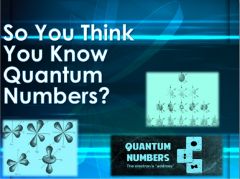
|
|
|
10 pts.
How many 1s orbitals are there in an atom? Answer: 1s = 1 orbital |
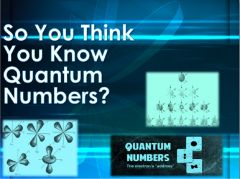
|
|
|
10 pts.
How many 4p orbitals are there in an atom? Answer: 4p = 3 orbitals |
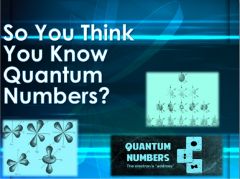
|
|
|
10 pts.
How many 4d orbitals are there in an atom? Answer: 4d = 5 orbitals |

|
|
|
20 pts.
What is the maximum number of orbitals when n = 4 and l = 1? Answer: 3 (the 4p orbitals) |
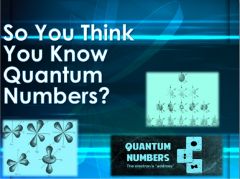
|
|
|
40 pts.
What are the shapes of s, p, and d orbitals respectively? Answer: s= spherical p = dumbbell d = cloverleaf |
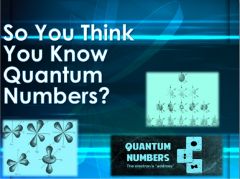
|
|
|
20 pts.
What is the maximum number of orbitals when n = 2 and l = 2? Answer: none (l must be < n) |
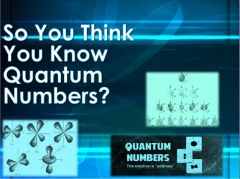
|
|
|
10 pts.
Which orbitals cannot exist? a. 2p b. 3p c. 4d d. 3f e. 6s f. 2d Answer: 3f and 2d |
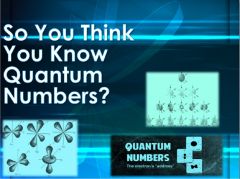
|
|
|
30 pts.
Write a set of quantum numbers for a 4f orbital. Answer: n = 4 l = 3 ml = 3, 2, 1, 0, -1, -2, -3 (answers may vary for ml, but must be in the range of -3 through +3) |
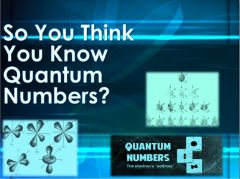
|
|
|
30 pts.
If an element possesses n = 3, what are the possible l values? What are the possible m values? Answer: l= 0, 1, 2 ml=-2, -1, 0, 1, 2 |
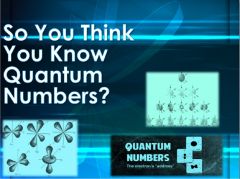
|
|
|
10 pts.
S orbitals have an azimuthal quantum number (l) of: a. 0 b. 1 c. 2 d. 3 Answer: A |
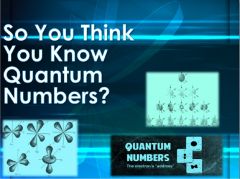
|
|
|
10 pts.
P orbitals have an azimuthal quantum number (l) of: a. 0 b. 1 c. 2 d. 3 Answer: B |
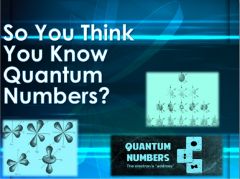
|
|
|
10 pts.
D orbitals have an azimuthal quantum number (l) of: a. 0 b. 1 c. 2 d. 3 Answer: C |

|
|
|
20 pts.
How many values of ml are there for l = 2? (d orbital) a. 1 b. 2 c. 5 d. 7 Answer: C |

|
|
|
20 pts.
Which quantum number describes the “shells” and “size” of orbitals? a. Principle b. Azimuthal c. Magnetic d. Spin Answer: A |
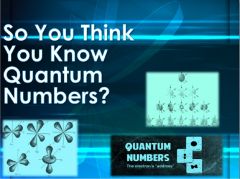
|
|
|
20 pts.
Which quantum number describes the shapes of the orbitals? a. Principle b. Azimuthal c. Magnetic d. Spin Answer: B |

|
|
|
20 pts.
Which quantum number describes the orientation of an orbital? a. Principle b. Azimuthal c. Magnetic d. Spin Answer: C |
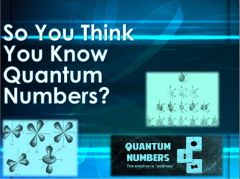
|
|
|
Which quantum number determines the energy of an electron in a hydrogen atom?
a. n b. l c. ml d. ms Answer: A |
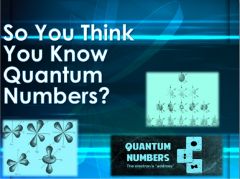
|
|
|
30 pts.
The spin quantum number is a result of: a. Aufbau Principle b. Pauli Exclusion Principle c. Heisenberg Uncertainty Principle d. Mendeleev’s Principle Answer: B |
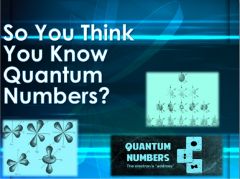
|
|
|
. 40 pts
What are the possible values of n and ml for an electron in a 5d orbital? Answer: n = 5 and ml = -2, -1, 0, +1, or +2 |
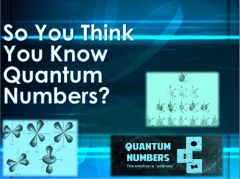
|
|
|
20 pts.
Which of the following is not a valid set of quantum numbers? a. n = 2, l = 1, ml = 0, and ms = -1/2 b. n = 2, l = 1, ml = -1, and ms = -1/2 c. n = 3, l = 0, ml = 0, and ms = 1/2 d. n = 3, l = 2, ml = 3, and ms = 1/2 Answer: D |
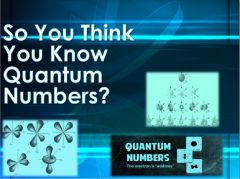
|
|
|
30 pts.
When n = 2, what values are valid for l? Answers: 0 or 1 |
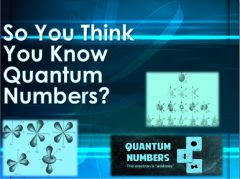
|
|
|
3o pts.
When l = 1, what are the possible values for ml? What is the letter represents the subshell? Answer: ml = -1, 0, or 1; p |
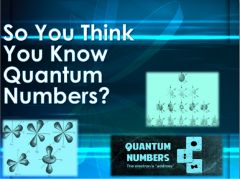
|
|
|
10 pts.
When l = 2, what letter represents the subshell? Answer: d |
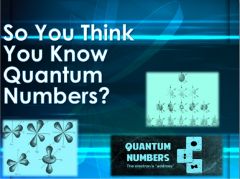
|
|
|
10 pts. When a subshell is labeled s, what is the value of l? What is the value of ml?
Answer: l = 0; ml = 0 |
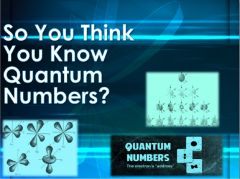
|
|
|
10 pts.
How many orbitals does a p subshell have? Answer: 3 |
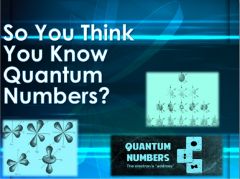
|
|
|
30 pts.
What is the principal quantum number and how is it represented? Answer: n is the principal quantum number and is the energy level; n describes the relative electron cloud size. |
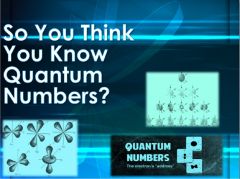
|
|
|
30 pts.
What is the azimuthal quantum number, how is it represented and found? Answer: l is the sublevel; it describes the shape of the electron cloud; found by n-1 |
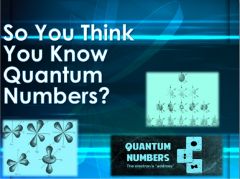
|
|
|
30 pts.
What is the magnetic quantum number, how is it represented and found? Answer: m, is the orbital; it describes the orientation in space of each orbital; found by –l…0…+l |
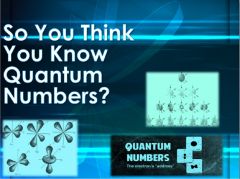
|
|
|
30 pts.
What is the spin quantum number, how is it represented and found? Answer: ms is the direction of the spin of the electron; can either be -1/2 or 1/2 |
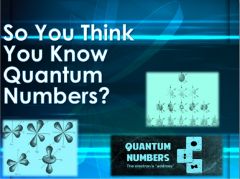
|
|
|
50 pts.
Describe the electrons defined by the following quantum numbers: n, l, and ml. n = 3 l = 0 ml = 0 Answer: 3s electron or orbital |
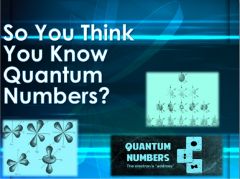
|
|
|
50 pts.
Describe the electrons defined by the following quantum numbers: n, l, and ml. n = 2 l = 1 ml = 1 Answer: 2p electron or orbital |
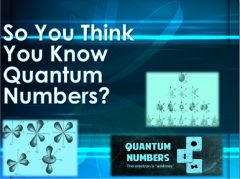
|
|
|
50 pts.
Describe the electrons defined by the following quantum numbers: n, l, and ml. n = 4 l = 2 ml = -1 Answer: 4d electron or orbital |

|
|
|
50 pts.
Describe the electrons defined by the following quantum numbers: n, l, and ml. n = 3 l = 3 ml = 2 Answer: not allowed (l must be < n) |
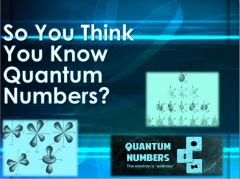
|
|
|
50 pts.
Describe the electrons defined by the following quantum numbers: n, l, and ml. n = 3 l = 1 ml = 2 Answer: not allowed (ml must be between -l and l) |
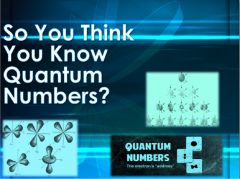
|

